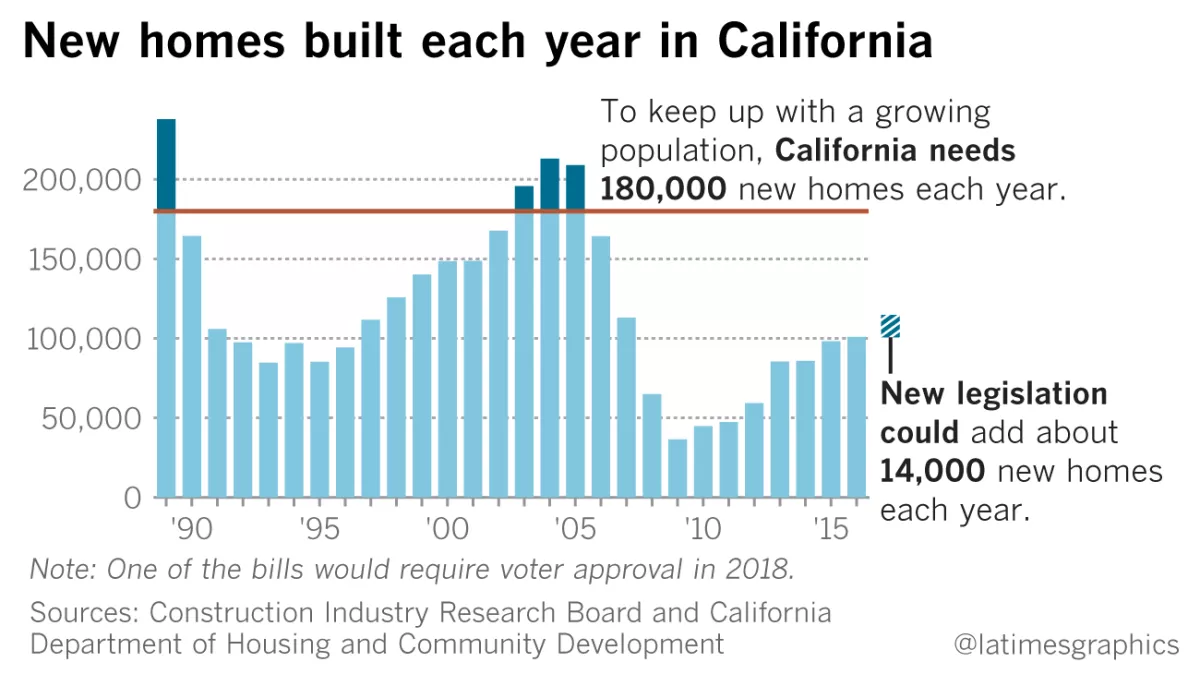California’s ongoing housing crisis has prompted lawmakers to introduce several pieces of legislation that increase density for real estate developers. These statutes offer a range of benefits, including the ability to build more units on a given site, incentives for building affordable housing, and streamlined permitting processes. Exploring each statute in detail also provides understanding of how to effectively combine the benefits of multiple statutes.
SB 9 – The Housing Crisis Act of 2019
Allows for two additional dwelling units on single-family residential lots. This statute has the potential to increase density in California’s urban and suburban areas by allowing for more units to be built on a given site. By adding two units to a single-family lot, developers can double or even triple the number of housing units on a site, depending on the size of the lot.
SB 9 does have some limitations, however. The statute does not require that any of the additional units be affordable, so developers may opt to build luxury units rather than units for low-income or working-class families. Additionally, local zoning laws may restrict the size and number of units that can be built on a site, so developers should carefully research the zoning laws in their target area before proceeding with a project.
AB 1763 – Density Bonus Law
https://www.reubenlaw.com/california-adds-incentives-for-developers-and-homeowners/
Provides a density bonus for affordable housing projects. Under this statute, developers who include affordable units in their projects can receive a density bonus that allows them to build more units on a site than would otherwise be allowed under local zoning laws. The density bonus is based on the percentage of affordable units included in the project, with higher percentages resulting in higher bonuses.
In addition to the density bonus, developers who include affordable units in their projects may also be eligible for incentives such as reduced parking requirements and streamlined permitting processes. These incentives can help make the development process faster and more cost-effective.
AB 2345 – Housing Crisis Act of 2020
Expands the availability of density bonuses for affordable housing projects. This statute allows developers to receive additional incentives for including affordable units in their projects, such as reduced parking requirements and expedited permitting processes.
One of the key benefits of AB 2345 is that it allows developers to qualify for a density bonus even if they are not building the maximum number of units allowed under local zoning laws. This can be particularly useful in areas where zoning laws are restrictive or where the demand for affordable housing is high.
SB 35 – Streamlined Approval Process for Multifamily Housing
Streamlines the approval process for certain multifamily housing projects. Under this statute, projects that meet certain requirements, such as including a minimum percentage of affordable units, are eligible for a streamlined approval process that bypasses many of the typical hurdles of the permitting process.
SB 35 can be a powerful tool for developers who are building affordable housing projects, as it allows them to get their projects approved more quickly and with less bureaucratic red tape. However, it should be noted that this streamlined approval process is only available for certain projects and in certain areas, so developers should carefully research the requirements before proceeding with a project.
Combining Statutes for Maximum Density
While each of these statutes offers unique benefits for real estate developers, combining multiple statutes can potentially result in even greater density gains. Here are a few potential combinations:
-
- SB 9 + AB 2345: By combining the Housing Crisis Act of 2021 with the Housing Crisis Act of 2020, developers could potentially build more units on a given site while also qualifying for additional incentives such as reduced parking requirements and streamlined permitting processes.
-
- AB 1763 + AB 2345: By combining the Density Bonus Law with the Housing Crisis Act of 2020, developers can receive additional incentives for including affordable units in their projects. This can be particularly useful in areas where zoning laws are restrictive or where the demand for affordable housing is high.
- AB 2345 + SB 35: Combining the Housing Crisis Act of 2020 with the Streamlined Approval Process for Multifamily Housing can provide developers with additional incentives for building affordable housing while also streamlining the permitting process for their projects.
- AB 1763 + AB 2345 + SB 35: Combining the Density Bonus Law, the Housing Crisis Act of 2020, and the Streamlined Approval Process for Multifamily Housing can provide developers with a range of incentives and streamlined permitting processes while also requiring the inclusion of affordable units in the project. This combination may be particularly useful for developers who want to prioritize affordable housing while also navigating restrictive zoning laws.
- SB 9 + AB 1763 + AB 2345: Combining the Housing Crisis Act of 2021, the Density Bonus Law, and the Housing Crisis Act of 2020 can provide developers with a range of incentives for building affordable housing while also allowing for increased density on a given site. This combination may be particularly useful for developers who want to maximize the number of units on a site while also addressing the need for affordable housing.
- SB 35 + SB 9 + AB 2345: Combining the Streamlined Approval Process for Multifamily Housing, the Housing Crisis Act of 2021, and the Housing Crisis Act of 2020 can provide developers with a range of incentives for building affordable housing while also streamlining the permitting process and allowing for increased density on a given site. This combination may be particularly useful for developers who want to prioritize affordable housing while also minimizing the time and resources required for the permitting process.
Each of these combinations has its own unique benefits and tradeoffs, and the best combination will depend on a variety of factors such as the location of the project, the size of the site, and the specific goals of the developer. For example, developers who are primarily focused on building affordable housing may want to prioritize AB 1763 and AB 2345, while developers who are primarily focused on maximizing the number of units on a site may want to prioritize SB 9 and AB 2345.
However, it is important to note that each of these statutes comes with its own set of tradeoffs. For example, while SB 9 allows for more units to be built on a given site, it does not require that any of these units be affordable. Similarly, while AB 1763 and AB 2345 provide incentives for building affordable housing, they may come with additional requirements such as including a certain percentage of affordable units in the project.
Furthermore, combining multiple statutes may also result in additional requirements and restrictions. For example, a project that qualifies for a density bonus under AB 1763 may also be subject to the additional requirements of AB 2345, such as including a certain percentage of affordable units in the project.
California’s statutes that increase density for real estate developers offer a range of benefits that can help address the state’s ongoing housing crisis. By carefully researching and combining these statutes, developers can potentially maximize the number of units on a given site while also qualifying for additional incentives and streamlining the permitting process. However, it is important to consider the tradeoffs of each statute and to carefully evaluate the requirements and restrictions of combining multiple statutes before proceeding with a project.
INSTRUCTIONS FOR IMPLEMENTATION
Here are some general instructions for implementing each of the following 4 California state statutes:
SB 35: Streamlined Approval Process for Multifamily Housing
Streamlines the approval process for certain types of multifamily housing developments that meet specific criteria. To take advantage of this law, developers must ensure that their project meets the following requirements:
-
- The project is located in an eligible zoning district and complies with the applicable zoning laws and regulations
- The project includes at least two-thirds of the units as residential
- The project meets certain affordability requirements, including at least 10% of the units being reserved for lower-income households
- The project complies with all applicable building codes and other requirements
To implement SB 35, developers must submit a streamlined application to the local planning department. The application must include specific information about the project, including the number and type of units, the affordability levels of the units, and other relevant details. The local planning department must then review the application and provide a decision within a specific timeframe. Here are the steps:
-
- Confirm eligibility: Confirm that the proposed development meets the requirements of SB 35. The development must be located in an urbanized area, and at least two-thirds of the units must be designated as affordable. Additionally, the development must comply with all local zoning and land use requirements.
- Notify the city: The developer must notify the local planning agency of the proposed development and request a preliminary application. The developer must also provide a notice of the proposed development to any relevant labor unions.
- Provide the application: Within 180 days of submitting the preliminary application, the developer must submit a completed application for the proposed development.
- Receive streamlined review: The local planning agency must provide a streamlined review of the application, including a streamlined review of any required environmental review.
- Approval or denial: If the local planning agency approves the application, the development can move forward. If the local planning agency denies the application, it must provide a written explanation for the denial.
- Compliance: Once the development is completed, the developer must ensure ongoing compliance with all relevant requirements, including the affordability requirements.
SB 9: Housing Development Opportunity
Allows for the creation of up to two residential units on a single-family lot in areas that are zoned for single-family use. To take advantage of this law, developers must ensure that their project meets the following requirements:
-
- The project is located in an eligible zoning district and complies with the applicable zoning laws and regulations
- The project includes no more than two units on a single-family lot
- The project complies with all applicable building codes and other requirements
To implement SB 9, developers must submit an application to the local planning department. The application must include specific information about the project, including the number and type of units, the design of the units, and other relevant details. The local planning department must then review the application and provide a decision within a specific timeframe. Here are the steps:
-
- Confirm eligibility: Confirm that the proposed development meets the requirements of SB 9. The development must be located in a residential area zoned for single-family homes and must comply with all local zoning and land use requirements.
- Provide notice to local agency: The developer must provide written notice to the local planning agency at least 90 days before applying for a permit. The notice must include the address of the proposed development, the number of units proposed, and a statement confirming compliance with all applicable requirements.
- Submit permit application: Once the notice has been provided, the developer can submit an application for a permit to the local planning agency. The application must include all required information and documentation.
- Receive streamlined review: The local planning agency must provide a streamlined review of the application, including a streamlined review of any required environmental review.
- Approval or denial: If the local planning agency approves the application, the development can move forward. If the local planning agency denies the application, it must provide a written explanation for the denial.
- Compliance: Once the development is completed, the developer must ensure ongoing compliance with all relevant requirements, including any affordability requirements, if applicable.
AB 1763: Density Bonus Law
Provides developers with incentives for including affordable housing units in their projects. To take advantage of this law, developers must ensure that their project meets the following requirements:
-
- The project includes at least 5% affordable units for projects with at least 5 units, or 10% affordable units for projects with at least 10 units
- The affordable units must be rented or sold at a price that is affordable to lower income households
- The project complies with all applicable building codes and other requirements
To implement AB 1763, developers must submit an application to the local planning department. The application must include specific information about the project, including the number and type of units, the affordability levels of the units, and other relevant details. The local planning department must then review the application and provide a decision within a specific timeframe. Here are the steps:
-
- Confirm eligibility: Confirm that the proposed development meets the requirements of AB 1763. The development must be located in a “jobs-rich” area, as defined in the statute, and must comply with all local zoning and land use requirements.
- Submit application: The developer must submit an application for the proposed development to the local planning agency. The application must include all required information and documentation, including a description of the proposed development and a statement confirming compliance with all applicable requirements.
- Receive streamlined review: The local planning agency must provide a streamlined review of the application, including a streamlined review of any required environmental review.
- Approval or denial: If the local planning agency approves the application, the development can move forward. If the local planning agency denies the application, it must provide a written explanation for the denial.
- Compliance: Once the development is completed, the developer must ensure ongoing compliance with all relevant requirements, including any affordability requirements, if applicable.
It is important to note that AB 1763 does not provide a density bonus but rather streamlines the approval process for certain developments in “jobs-rich” areas. Developers may still be eligible for a density bonus under other statutes, such as SB 35 or AB 2345.
AB 2345: Housing Crisis Act of 2020
Provides additional incentives for developers to include affordable units in their projects. To take advantage of this law, developers must ensure that their project meets the following requirements:
-
- The project includes at least 15% affordable units for projects with at least 5 units, or 20% affordable units for projects with at least 10 units
- The affordable units must be rented or sold at a price that is affordable to lower-income households
- The project complies with all applicable building codes and other requirements
To implement AB 2345, developers must submit an application to the local planning department. The application must include specific information about the project, including the number and type of units, the affordability levels of the units, and other relevant details. The local planning department must then review the application and provide a decision within a specific timeframe. Here are the steps:
-
- Confirm eligibility: Confirm that the proposed development meets the requirements of AB 2345. The development must include at least two-thirds affordable units, meet certain income eligibility requirements, and comply with all local zoning and land use requirements.
- Submit application: The developer must submit an application for the proposed development to the local planning agency. The application must include all required information and documentation, including a description of the proposed development and a statement confirming compliance with all applicable requirements.
- Receive density bonus: If the proposed development meets the requirements of AB 2345, the developer is eligible for a density bonus of up to 80 percent above the maximum allowable density under local zoning requirements.
- Provide community benefits: In exchange for the density bonus, the developer must provide certain community benefits, such as providing additional affordable housing units or contributing to a public infrastructure project.
- Approval or denial: If the local planning agency approves the application, the development can move forward. If the local planning agency denies the application, it must provide a written explanation for the denial.
- Compliance: Once the development is completed, the developer must ensure ongoing compliance with all relevant requirements, including any affordability requirements.
It is important to note that these are general instructions and that the specific requirements and processes, and that AB 2345 only applies to developments that meet specific affordability and income eligibility requirements. Developers may also be eligible for a density bonus under other statutes, such as SB 35 or AB 1763, if they do not meet the requirements of AB 2345.


